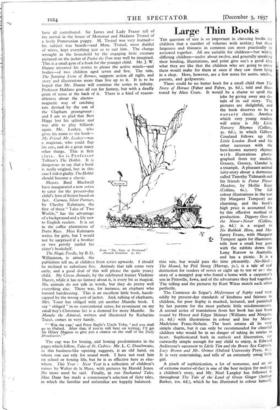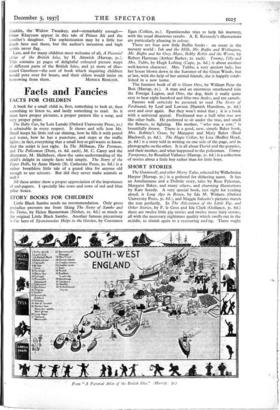Large Thin Books
THE question of size is so important in choosing books for children that a number of volumes with nothing but their largeness and thinness in common can most practically be reviewed together. All are suitable for children—but widely differing children—under about twelve, and generally speaking their binding, illustrations, and print give sues a good idea what they are like that the children who are going to enjoy them would make for them at once if they saw them lying in a shop. Here, however, are a few notes for aunts, uncles, parents, and godparents.
which very young readers will enjoy is My Little Nursery Rhymes (Collins, 3s. 6d.), in which Gilbert Cousland follows up My Little London Book and his other successes with the best-known nursery rhymes with illustrations photo- graphed from toy models. Goosey, Goosey, Gander is a triumph. A pleasant animal fairy-story about a dormouse called Timothy Tidmarsh and his friends is Potter Pinner Meadow, by Mollie Kaye (Collins, 6s.). The full colour illustrations in the text (by Margaret Tempest) are charming, and the book's high price is accounted for by this effective method of production. Diggory -Goes to the Never - Never (Coffins, 3s. 6d.) is a sequel to No Rubbish _ Here, and My- fanwy Evans, with Margaret Tempest again for -illustrator, tells _how a small boy goes with the rabbits -chOwn the Long Burrow to Australia,
and has a picnic. It :is a
thin tale, but would pass the time pleasantly. _NO,Sitch : The Hound, by Phil Stong (Harrap, is.), is a tale: of real distinction for readers of seven or eight up to ten or so ~ the story of a mongrel pup who found a home with a carpenter's son in Pittsville, Iowa, and of the adventures they had together. The telling and the pictures by Kurt Wiese match 'each 'other perfectly.
The Comtesse de Segur's Misfortunes of Sophy read very oddly by present-thy standards of kindness and fairness to children, for poor Sophy is mocked, lectured, and punished by her parents for the most pathetic little misdemeanours. A second series of translations from her boa has just been issued by Honor and Edgar Skinner (Williams and .Norgate, as: 6d.) with illustrations in colour and line by Marie- Madeleine Franc-Nohain. The book retains all 'its very simple charm, but it can only be recommended for cheerful children who would be in no danger of taking its atones to heart.: Sophisticated both in outlook and illustration; yet outwardly simple enough for any child to enjoy, is Edward Ardizzone's successor to Little Tim and the Brarie Sea Captain, Lucy Brown and Mr. Grimes (Oxford University West, 6s.). It is very entertaining, and tells of an extremely -sting little girl.
A pinch of sophistication, a lot of nonsense, and an air of extreme matter-of-fact is one of the best recipes. for making a children's story, and Mr.-.Noel -Langley- has followed it L throughout The Tale of the' and -of Green -Ginger '(Arthur Barker, los. 6d.), which he has illustrated in colour himself. Aladdin, - the - WideW: Twankey, and—remarkably gnough- Omar Khayyam appear in this tale of Prince Ali and the jeweller's daughter. The sophistication may be a little too much here and there; but the author's invention and high spirits never flag.
Last, and for many children most welcome of all, A Pictorial Atlas of the British Isles, by H. Ainwick (Harrap, 5s.). This contains 32 pages of delightful coloured picture maps of different parts of the -British Isles, and- 32 more of illus- trated Gazei-teer—the sort of book which inquiring 'Children would pore over fof hours, and their elders would insist on



























































 Previous page
Previous page